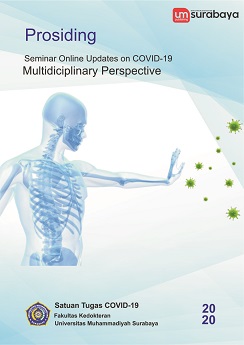Peranan Kalsium dan Vitamin D Dalam Penanganan Osteoporosis, Pencegahan Fraktur Patologis, Serta Korelasi Terhadap Pandemi COVID-19
Abstrak
AbstractOsteoporosis remains a very significant public health problem, causing high morbidity and
mortality rates. Vitamin D deficiency (<50 nmol / L) is a worldwide epidemic with multiple
implications for human health. Inadequate serum 25-hydroxyvitamin D (25 (OH) D)
concentrations are associated with muscle weakness, decreased physical performance, and an
increased likelihood of falls and fractures. Various studies have shown that higher serum 25
(OH) D levels (at least 700 IU of vitamin D, especially cholecalciferol) will reduce the
incidence of fractures. The problem of osteoporosis has been exacerbated by the COVID-19
pandemic. As well known, COVID-19 is a respiratory tract infection caused by the new SARSCoV-2 virus. In general, this pandemic has caused deterioration of the economic and health
care systems in many countries. Under difficult circumstances, recent research has shown that
optimizing blood levels of vitamin D offers a solution that promises to reduce the risk of death
from COVID-19 infection. This literature review was aimed to discuss the role of calcium and
vitamin D in the management of osteoporosis, pathological fractures (brittle fractures), and
COVID-19.
Keywords: osteoporosis, vitamin D, COVID-19
Referensi
JAMA. (2001). Osteoporosis prevention, diagnosis, and therapy. 285(6):785-795.
Bauer DC, Sklarin PM, Stone KL, Black DM, Nevitt MC, Ensrud KE, Arnaud CD, Genant HK,
Garnero P, Delmas PD et al. (1999). Biochemical markers of bone turnover and prediction of hip
bone loss in older women: the study of osteoporotic fractures. J Bone Miner. 14(8):1404–1410.
Curr Osteoporos Rep (2011) 9:36–42
Nguyen ND, Pongchaiyakul C, Center JR, Eisman JA, Nguyen TV. (2005). Identification of
high-risk individuals for hip fracture: a 14-year prospective study. J Bone Miner Res,
(11):1921–1928.
Snijder MB, et al. (2006). Vitamin D status in relation to one-year risk of recurrent falling in
older men and women. J Clin Endocrinol Metab, 91(8):2980–2985.
Wicherts IS, van Schoor NM, et al. (2007). Vitamin D status predicts physical performance and
its decline in older persons. J Clin Endocrinol Metab, 92(6):2058–2065.
Van Schoor NM, Visser M, Pluijm SM, et al. (2008). Vitamin D deficiency as a risk factor for
osteoporotic fractures. Bone, 42(2):260–266
WHO. (2020). Clinical Management of COVID-19. World Health Organization;
May. Diakses dari: https://www.who.int/publications/i/item/clinical-management-ofcovid-19
Stahel PF. (2020). How to risk-stratify elective surgery during the COVID-19 pandemic?. Patient
Saf Surg. 2020; 14: 8. https://doi.org/10.1186/s13037-020-00235-9 Published
Mar 31
Kanis JA, et al. (2001). The burden of osteoporotic fractures: a method for setting intervention
thresholds. Osteoporos Int; 12(5):417–427
National Institute for Health and Clinical Excellence. (2012). Osteoporosis: Assessing the Risk
of Fragility Fracture. NICE Clinical Guideline 146. London: NICE diakses pada Oktober 2020
dari: http://www.nice.org.uk/CG146
Upadhyaya GK, et al. (2020). Challenges and strategies in management of osteoporosis and
fragility fracture care during COVID-19 pandemic. Professor P K Surendran Memorial
Education Foundation. Published by Elsevier.
Shariyate M, Kachooei A. (2020). Association of new coronavirus disease with fragility hip and
lower limb fractures in elderly patients. The Archives of Bone and Joint Surgery; 8:297–301.
https://doi.org/10.22038/abjs.2020.47626.2333132 | H a l a m a n
British Geriatrics Society. (2020). Managing Hip Fractures during COVID-19. Diakses pada
Oktober 2020 dari: https://www.bgs.org.uk/blog/managing-hip-fractures-during-covid19
NHS England. (2020). Specialty Guide for Coronavirus. Diakses pada Oktober 2020 dari:
Miller MD, Thompson SR. (2016). Miller’s Review of Orthopaedics 7th Ed. Philadelphia:
Elsevier.
Quesada JM, Coopmans W, Ruiz B, et al. (1992). Influence of vitamin D on parathyroid function
in the elderly. J Clin Endocrinol Metab, 75(2):494–501.
Lips P. (2001). Vitamin D deficiency and secondary hyperparathyroidism in the elderly:
consequences for bone loss and fractures and therapeutic implications. Endocr Rev, 22(4):477–
Sunyecz JA. (2008). The use of calcium and vitamin D in the management of osteoporosis.
Therapeutics and Clinical Risk Management 2008:4(4) 827–836 publisher and licensee Dove
Medical Press Ltd.
Weaver CM, Fleet JC. (2004). Vitamin D requirements: current and future. Am J Clin Nutr,
(suppl):1735S–9S.
Holick MF. (2006). Resurrection of vitamin D deficiency and rickets. J Clin Invest, 116:2062–
National Osteoporosis Foundation. (2008). Clinicians guide to prevention and treatment of
osteoporosis (online). Accessed on October 10, 2020. URL:
http://www.nof.org/professionals/NOF_Clinicians_Guide.pdf
Wicherts IS, et al. (2007). Vitamin D status predicts physical performance and its decline in older
persons. J Clin Endocrinol Metab, 92(6):2058–2065
Holick MF. (2007). Vitamin D deficiency. N Engl J Med, 357
(3):266–281.
Bischoff HA, et al. (2001). In situ detection of 1,25-dihydroxyvitamin D3 receptor in human
skeletal muscle tissue. Histochem J, 33(1):19–24.
Bischoff HA, et al. (2004). Vitamin D receptor expression in human muscle tissue decreases with
age. J Bone Miner Res, 19(2):265– 269.
Janssen HC, Samson MM, Verhaar HJ, (2002). Vitamin D deficiency, muscle function, and falls
in elderly people. Am J Clin Nutr, 75(4):611–615
Dhesi JK, et al. (2002). Neuromuscular and psychomotor function in elderly subjects who fall
and the relationship with vitamin D status. J Bone Miner Res, 17(5):891–897.
Pfeifer M, Begerow B, Minne HW. (2002). Vitamin D and muscle function. Osteoporos Int,
(3):187–194.
Visser M, Deeg DJ, Lips P. (2003). Low vitamin D and high parathyroid hormone levels as
determinants of loss of muscle strength and muscle mass (sarcopenia): the Longitudinal Aging
Study Amsterdam. J Clin Endocrinol Metab, 88(12):5766–5772.
Bischoff HA, et al. (2004). Higher 25-hydroxyvitamin D concentrations are associated with better
lower-extremity function in both active and inactive persons aged > or =60 y. Am J Clin Nutr,
(3):752–758.
Pfeifer M, Begerow B, Minne HW, et al. (2009). Effects of a long-term vitamin D and calcium
supplementation on falls and parameters of muscle function in community-dwelling older
individuals. Osteoporos Int, 20 (2):315–322.
Bischoff HA, et al. (2003). Effects of vitamin D and calcium supplementation on falls: a
randomized controlled trial. J Bone Miner Res, 18(2):343–351.
Di Rosa M, Malaguarnera M, Nicoletti F, Malaguarnera L. (2011). Vitamin D3: a helpful
immuno-modulator. Immunology;134:123e39
Subramanian K, Bergman P, Henriques-Normark B. (2017). Vitamin D promotes pneumococcal
killing and modulates inflammatory responses in primary human neutrophils. J Innate Immun;
:375e86.
Adams JS, et al. (2009). Vitamin ddirected rheostatic regulation of monocyte antibacterial
responses. J Immunol. Apr 1;182:4289e95.






